Investigation on the Impact of Trailing Edge Stacking Styles on Hydraulic Performance in the Multistage Submersible Pump Space Diffuser
Abstract
:1. Introduction
2. Computational Domain and Meshing
2.1. Computational Domain
2.2. Compute Mesh Independence Test
2.3. Experiment and Simulation Validation
3. Preliminary Design and Analysis
3.1. Wrap Angle Difference
3.2. Linear Equation of the Space Diffuser Trailing Edge
3.3. Evaluation Indictor
3.4. Initial Value of the Wrap Angle Difference
4. Results and Discussion
4.1. Optimization Cases in Positive Wrap Angle Difference
4.2. Analysis of the Optimization Results
4.3. Hydrodynamic Analysis of the Variable Shroud Wrap Angle (Scheme A)
4.4. Hydrodynamic Analysis of the Variable Hub Wrap Angle (Scheme B)
5. Conclusions
- (1)
- The increasing wrap angle difference within a specific range can alleviate the accumulation of the low-energy fluid and suppress the generation of the secondary flow separation vortex at the hub surface. When the wrap angle difference is a positive value, the wrap angle of the space diffuser decreases gradually from the hub to the shroud surface, and the shroud wrap angle is lower than the hub. The inner secondary flow on the hub surface has been suppressed. Then the separation vortex in the corner region of the diffuser middle section has been diminished. So, the hydraulic efficiency with the positive wrap angle difference exceeds the negative wrap angle difference. That is, the space diffuser hydraulic performance with the negative stacking style () of the trailing edge is better than the positive one ().
- (2)
- Secondary flow scouring induced by the extensional or transversal pressure differences of the diffuser leading edge, coupled with the obstructive effect of the extensional or transversal pressure differences on the diffuser trailing edge on low-energy fluid, ultimately triggers the generation of the hub-corner separation vortex.
- (3)
- To investigate the effects of the variable shroud and hub wrap angles on the internal flow field and hydraulic performance of the space diffuser, two schemes have been conducted, by reducing the impeller wrap angle and increasing the hub wrap angle within the range of [0, ] to enhance the wrap angle difference. When the hub wrap angle keeps constant and the shroud wrap angle reduces, the transverse secondary flow from the pressure surface to the suction surface at the middle section of the space diffuser is weakened, and the accumulation of low-energy fluid at the corner region is suppressed. Meanwhile, the extensional secondary flow from the hub to the shroud surface is enhanced, which drains the low-energy flow to the middle of the blade and flows out smoothly. Therefore, in the negative stacking style of the trailing edge scheme () with a reduced shroud wrap angle, the secondary flow scouring at the leading edge is suppressed, and the low-energy fluid at the trailing edge is drained, both of which contribute to the overall improvement in the space diffuser’s hydraulic performance, and the optimum case at .
- (4)
- When the shroud wrap angle remains constant and the hub wrap angle increases, the secondary flow from the hub to the shroud at the middle region of the space diffuser increases, which leads to the number of the accumulation of low-energy fluid at the corner region being reduced. However, the intensification of extensional scouring from the shroud to the hub at the inlet and the secondary flow from the suction to the pressure surface to appear. It promotes the formation of separation vortexes. As a result, in the negative stacking style of the trailing edge scheme () with increased hub wrap angle, the secondary flow scouring at the leading edge is intensified, and the low-energy fluid at the trailing edge is drained, leading to a mutual cancellation effect that results in the appearance of performance extremes, and the optimum case at .
Author Contributions
Funding
Data Availability Statement
Conflicts of Interest
References
- Stel, H.; Sirino, T.; Ponce, F.J.; Chiva, S.; Morales, R.E. Numerical investigation of the flow in a multistage electric submersible pump. J. Pet. Sci. Eng. 2015, 136, 41–54. [Google Scholar] [CrossRef]
- Bulgarelli, N.A.V.; Biazussi, J.L.; Verde, W.M. Experimental investigation of the electrical submersible pump’s energy consumption under unstable and stable oil/water emulsions: A catastrophic phase inversion analysis. J. Pet. Sci. Eng. 2022, 216, 110814. [Google Scholar] [CrossRef]
- Wei, Q.; Sun, X.; Shamseldin, A. Numerical study on the impact of the coupling of diffuser parameters on the performance of submersible pumps used in town water distribution systems. J. Braz. Soc. Mech. Sci. 2019, 41, 408. [Google Scholar] [CrossRef]
- Guan, X. Modern Pump Design Theory; China Space Agency Press: Beijing, China, 2011. [Google Scholar]
- Gao, Y.; Cao, W.D.; Zhang, Y. Investigation of high-speed deep well pump performance with different outlet setting angle of space diffuser. Front Energy Res. 2023, 10, 1072901. [Google Scholar] [CrossRef]
- Xu, L.; Guo, T.; Wang, W. Effects of vortex structure on hydraulic loss in a low head Francis turbine under overall operating conditions base on entropy production method. Renew. Energy 2022, 198, 367–379. [Google Scholar]
- Qin, Y.; Li, D.; Wang, H. Investigation on the relationship between hydraulic loss and vortex evolution in pump mode of a pump-turbine. J. Hydrodyn. 2022, 34, 555–569. [Google Scholar] [CrossRef]
- Goto, A.; Nohmi, M.; Sakurai, T.; Sogawa, Y. Hydrodynamic design system for pumps based on 3-D CAD, CFD and inverse design method. J. Fluids Eng. 2002, 124, 329–335. [Google Scholar] [CrossRef]
- Scillitoe, A.D.; Tucker, P.G.; Adami, P. Numerical investigation of three-dimensional separation in an axial flow compressor: The influence of free stream turbulence intensity and end wall boundary layer state. J. Turbomach. 2017, 139, 021011. [Google Scholar] [CrossRef]
- Gbadebo, S.A.; Cumpsty, N.A.; Hynes, T.P. Three-dimensional separations in axial compressors. J. Turbomach. 2005, 12, 331–339. [Google Scholar] [CrossRef]
- Goto, A.; Zangeneh, M. Hydrodynamic design of pump diffuser using inverse design method and CFD. J. Fluids Eng. 2002, 124, 319–328. [Google Scholar] [CrossRef]
- Zangeneh, M.; Goto, A. Turbo-Design—1: Next Generation Design Software for Pumps; Elsevier: Amsterdam, The Netherlands, 2003; Volume 437. [Google Scholar]
- Zhao, Q. Diversion shell geometry parameters selection and its influence on the pump performance. J. Taiyuan Univ. Technol. 2002, 33, 414–416. [Google Scholar]
- Zhang, R.; Guo, R.; Yang, J.; Li, R. Analysis of flow in vane diffuser and its optimization based on CFD methods. J. Drain. Irrig. Mach. Eng. 2015, 33, 762–767. [Google Scholar]
- Beselt, C.; Eck, M.; Peitsch, D. Three-dimensional flow field in highly loaded compressor cascade. J. Turbomach. 2014, 136, 101007. [Google Scholar] [CrossRef]
- Gregory-Smith, D.; Bagshaw, D.; Ingram, G. Using profiled end walls, blade lean and leading edge extensions to minimize secondary flow. In Proceedings of the ASME Turbo Expo 2008: Power for Land, Sea, and Air, Berlin, Germany, 9–13 June 2008; pp. 1301–1311. [Google Scholar]
- He, X.; Zheng, X. Mechanisms of sweep on the performance of transonic centrifugal compressor impellers. Appl. Sci. 2017, 7, 1081. [Google Scholar] [CrossRef]
- Rosic, B.; Xu, L. Blade lean and shroud leakage flows in low aspect ratio turbines. J. Turbomach. 2011, 134, 031003. [Google Scholar] [CrossRef]
- Ma, Z.; Zhu, B.; Rao, C.; Shangguan, Y. Comprehensive hydraulic improvement and parametric analysis of a Francis turbine runner. Energies 2019, 12, 307. [Google Scholar] [CrossRef]
- Liu, L.; Zhu, B.; Bai, L.; Liu, X.; Zhao, Y. Parametric design of an ultrahigh-head pump-turbine runner based on multi-objective optimization. Energies 2017, 10, 1169. [Google Scholar] [CrossRef]
- Razavi, S.R.; Sammak, S.; Boroomand, M. Multidisciplinary design and optimizations of swept and leaned transonic rotor. J. Eng. Gas Turbines Power 2017, 139, 122601. [Google Scholar] [CrossRef]
- He, X.; Zheng, X. Performance improvement of transonic centrifugal compressors by optimization of complex three-dimensional features. Proc. Inst. Mech. Eng. G 2017, 231, 2723–2738. [Google Scholar] [CrossRef]
- Jang, C.; Samad, A.; Kim, K. Optimal design of swept, leaned and skewed blades in a transonic axial compressor. In Proceedings of the ASME Turbo Expo 2006: Power for Land, Sea, and Air, Barcelona, Spain, 8–11 May 2006; pp. 1279–1288. [Google Scholar]
- Jang, C.; Samad, A.; Kim, K. Optimal design for stacking line of rotor blade in a single-stage transonic axial compressor. KSFM J. Fluid Mach. 2006, 9, 7–13. [Google Scholar]
- Sahin, F.C. Experimental investigation on flow improvement in compressor cascades. Trans. Chin. Soc. Agric. Eng. 2017, 41, 526–539. [Google Scholar]
- Ananthakrishnan, K.; Govardhan, M. Influence of fillet shapes on secondary flow field in a transonic axial flow turbine stage. Aerosp. Sci. Technol. 2018, 82, 425–437. [Google Scholar] [CrossRef]
- Shi, W.; Zhou, L.; Lu, W.; Xu, L.; Li, W. Numerical Simulation and Experimental Study of Different Stages Deep-Well Centrifugal Pump. J. Comput. Theor. Nanosci. 2013, 10, 2897–2901. [Google Scholar] [CrossRef]
- Cao, P.; Zhu, R.; Yin, G. Spike-type disturbances due to inlet distortion in a centrifugal pump. Renew. Energy 2021, 165, 288–300. [Google Scholar] [CrossRef]
- Yuan, S.Q.; He, W.T.; Si, Q.R.; Yuan, J.P.; Zhang, H.Y.; Cui, Q.L. Numerical simulation on gas-liquid two-phase flow in centrifugal pump based on MUSIG model. J. Drain. Irrig. Mach. Eng. 2021, 39, 325–330. [Google Scholar]
- Zhou, L.; Wang, W.; Hang, J.; Shi, W.; Yan, H.; Zhu, Y. Numerical Investigation of a High-Speed Electrical Submersible Pump with Different End Clearances. Water 2020, 12, 1116. [Google Scholar] [CrossRef]
- Zhou, L.; Bai, L.; Shi, W.; Li, W.; Wang, C.; Ye, D. Numerical analysis and performance experiment of electric submersible pump with different diffuser vanes number. J. Braz. Soc. Mech. Sci. Eng. 2018, 40, 89. [Google Scholar] [CrossRef]
- Ning, C.; Cao, P.; Gong, X.; Zhu, R. Optimization of sweep and blade lean for diffuser to suppress hub corner vortex in multistage pump. Machines 2021, 12, 316. [Google Scholar] [CrossRef]
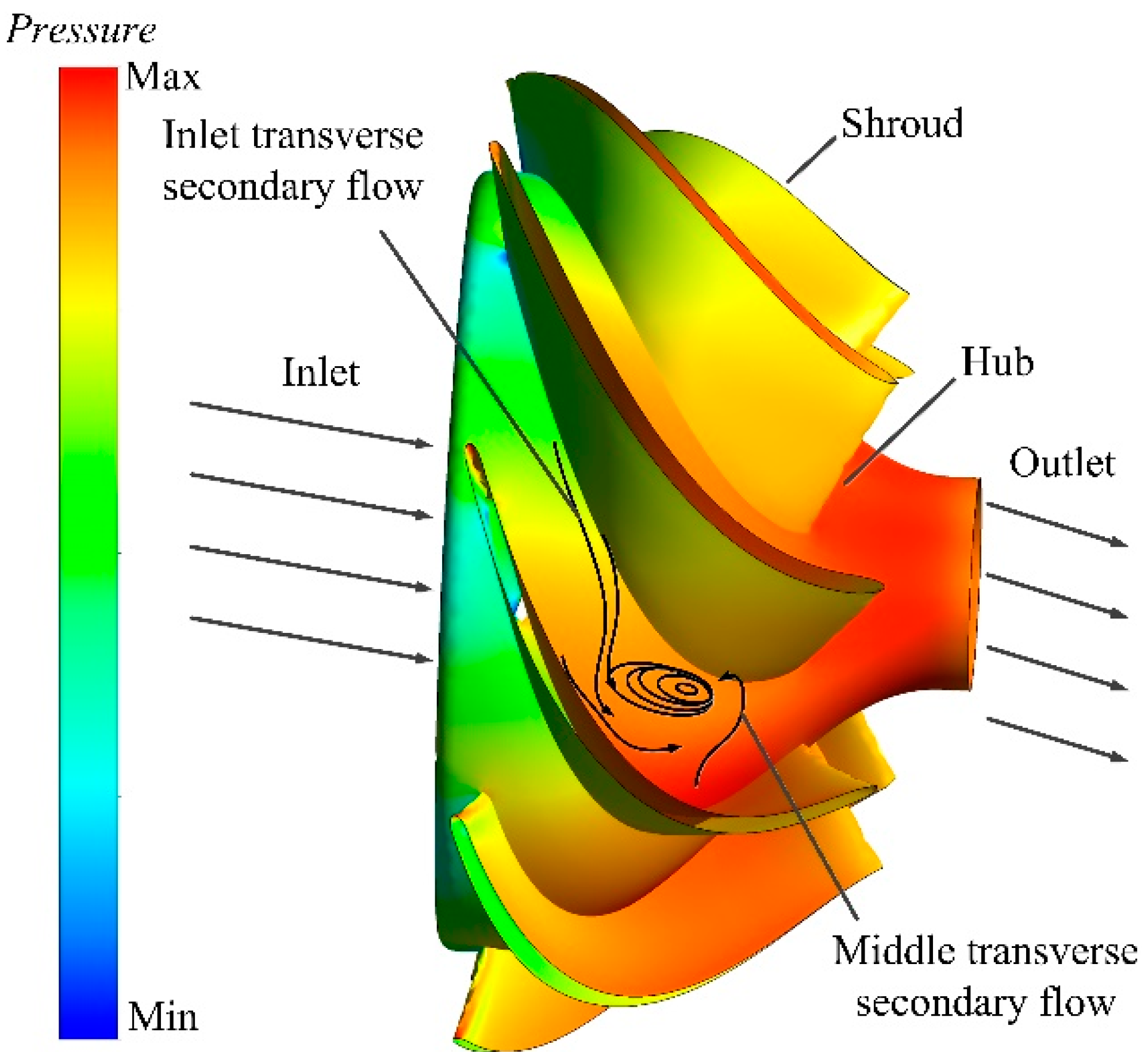






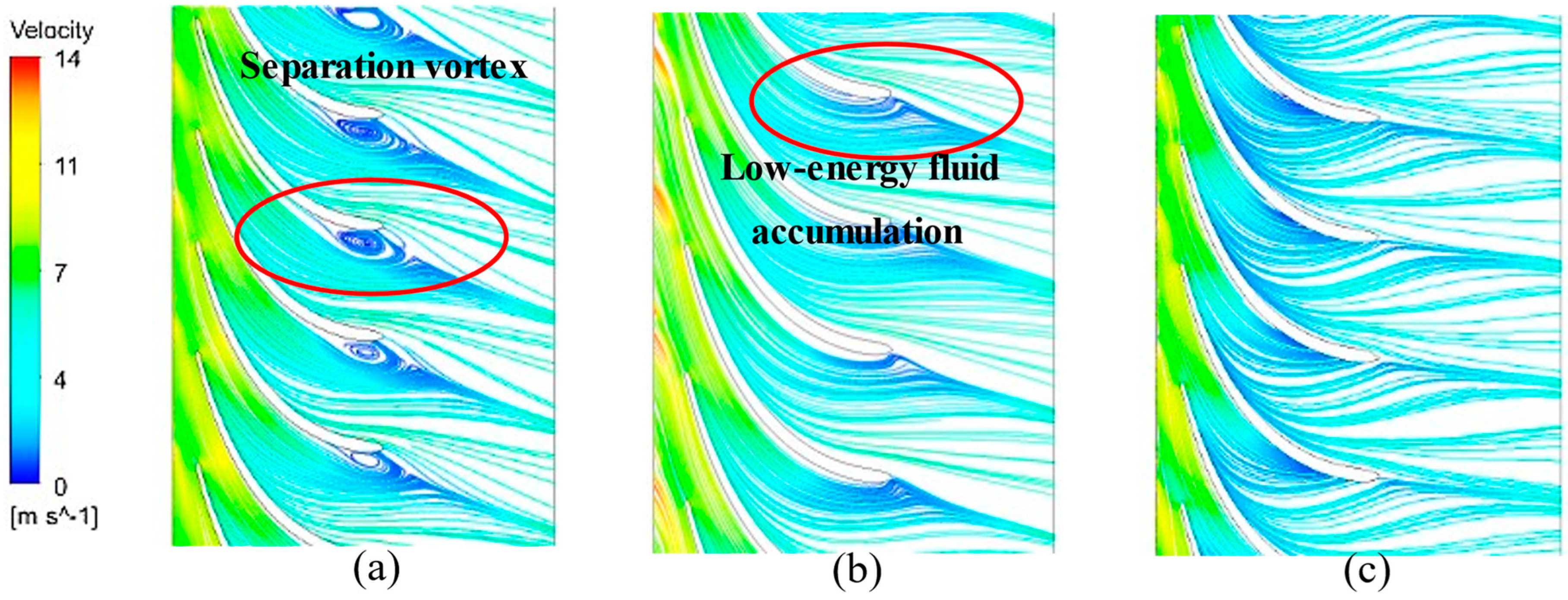

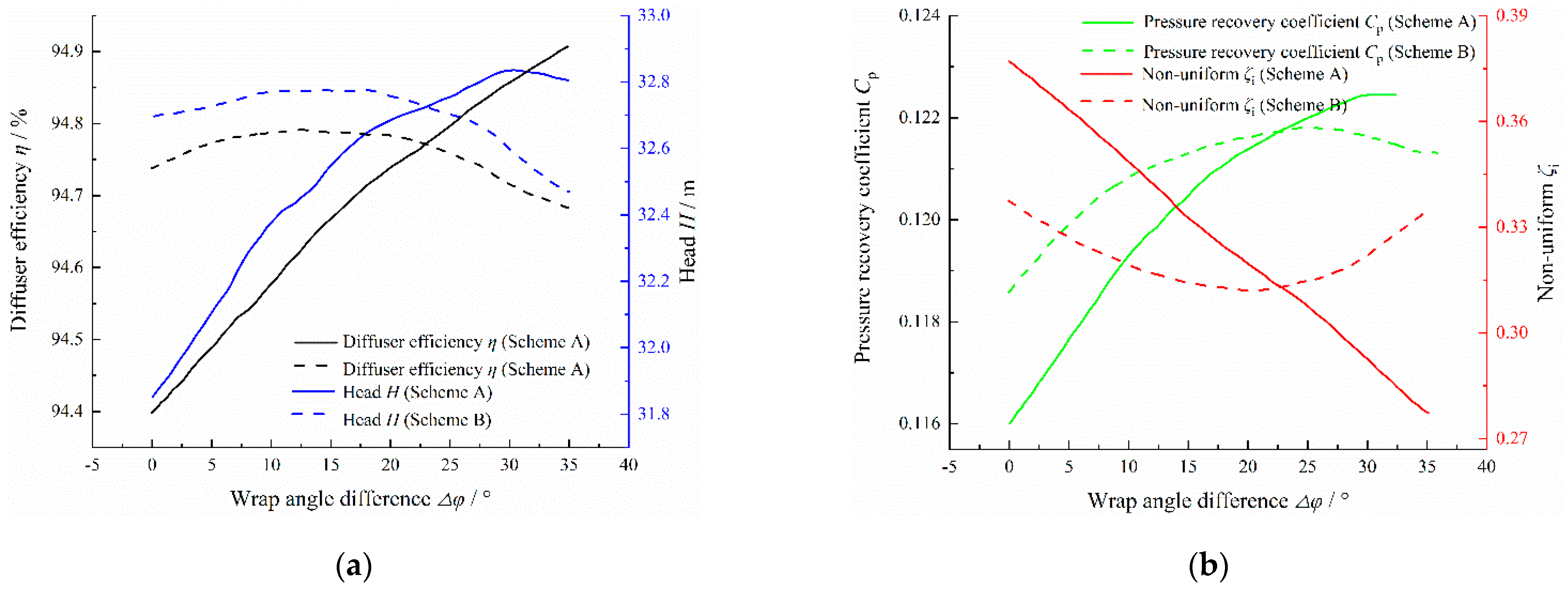
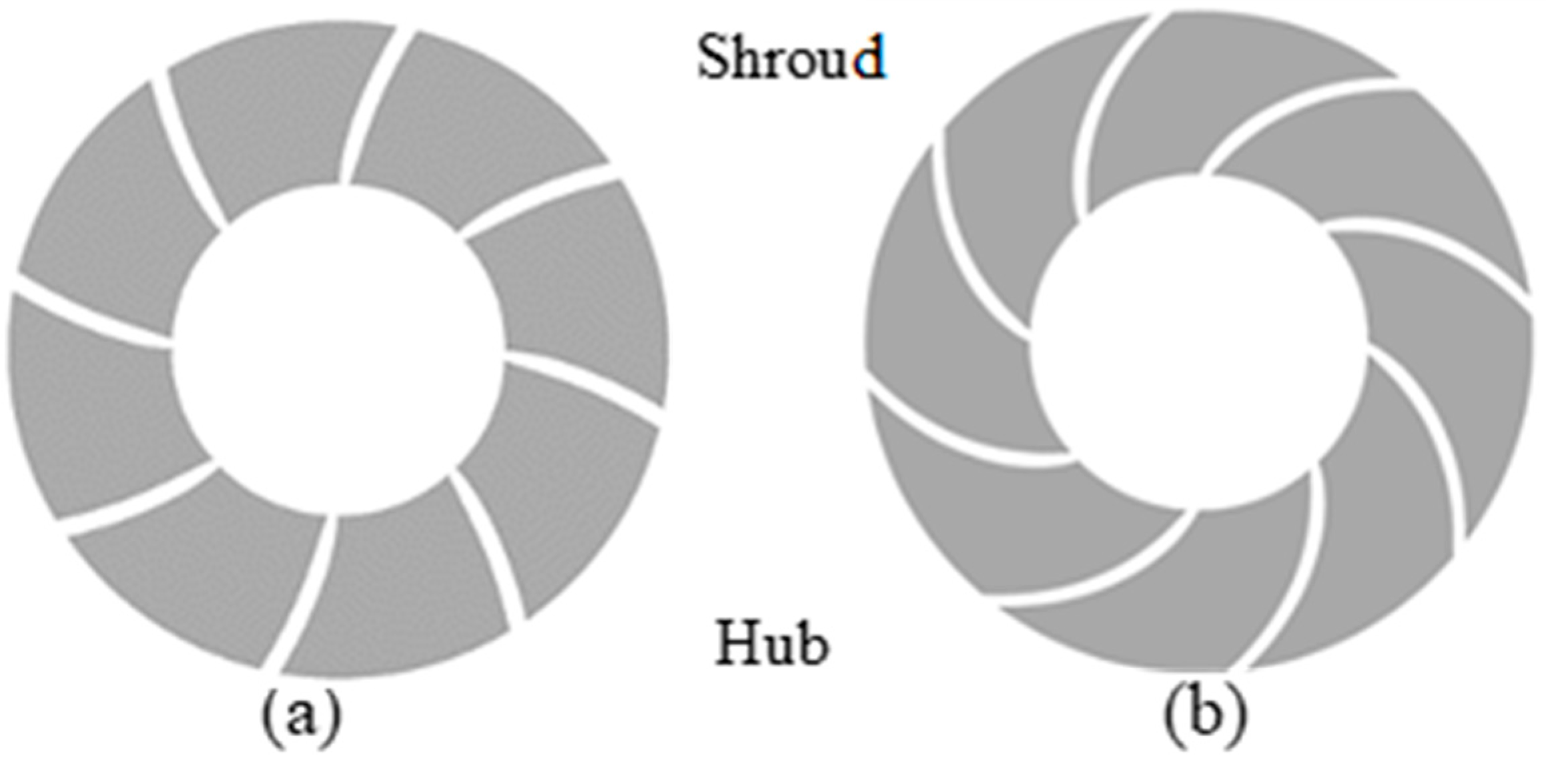
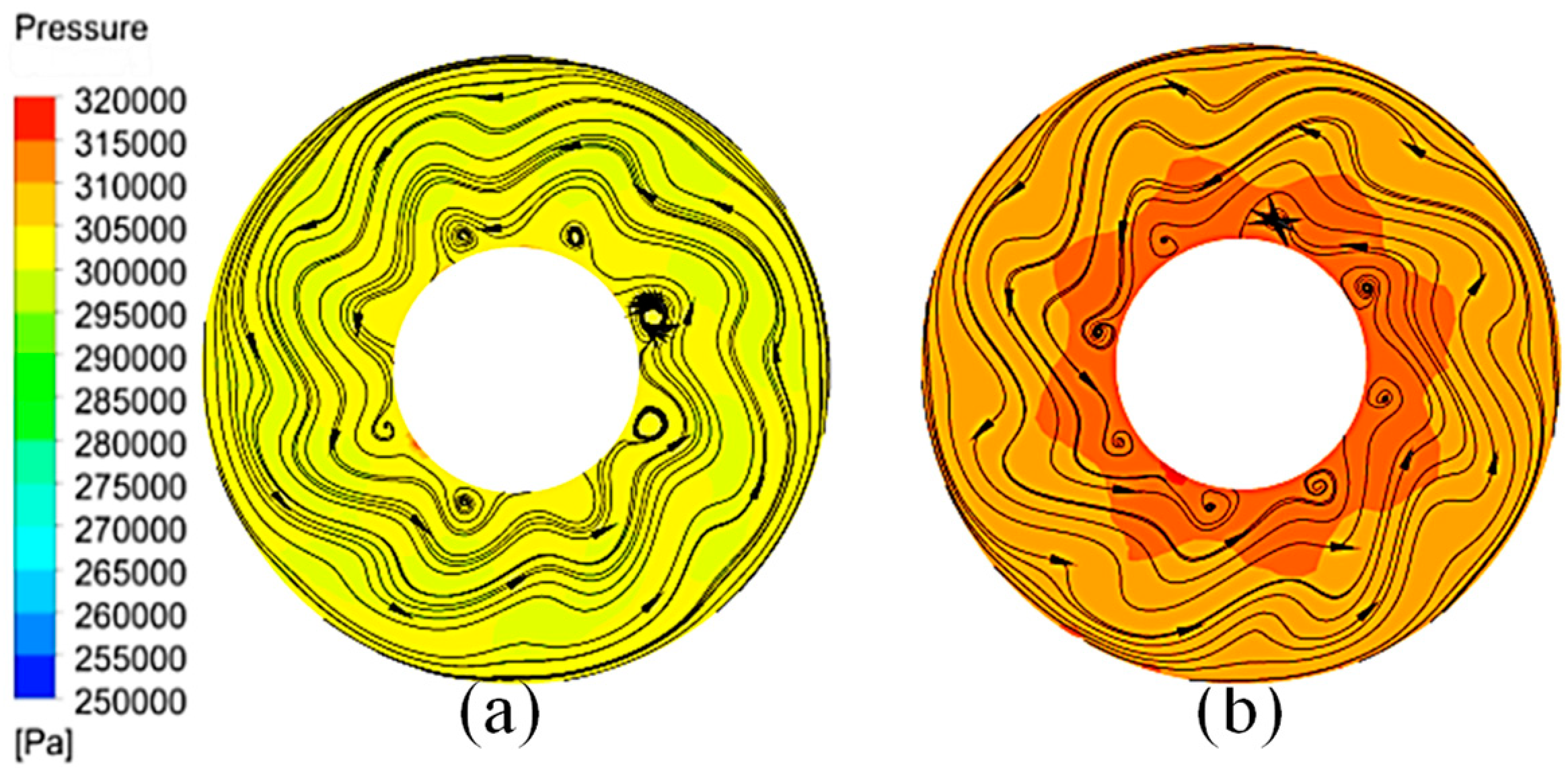
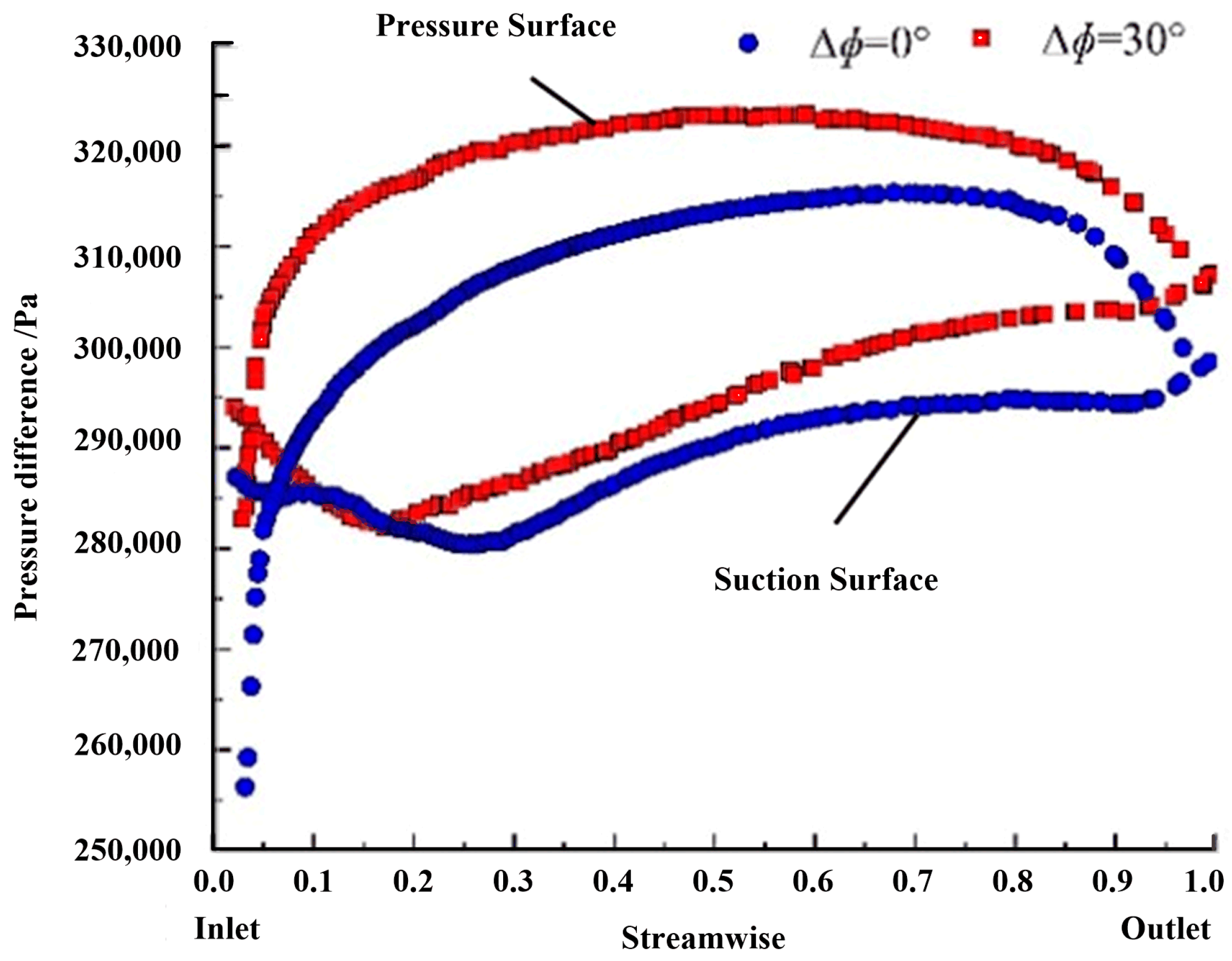
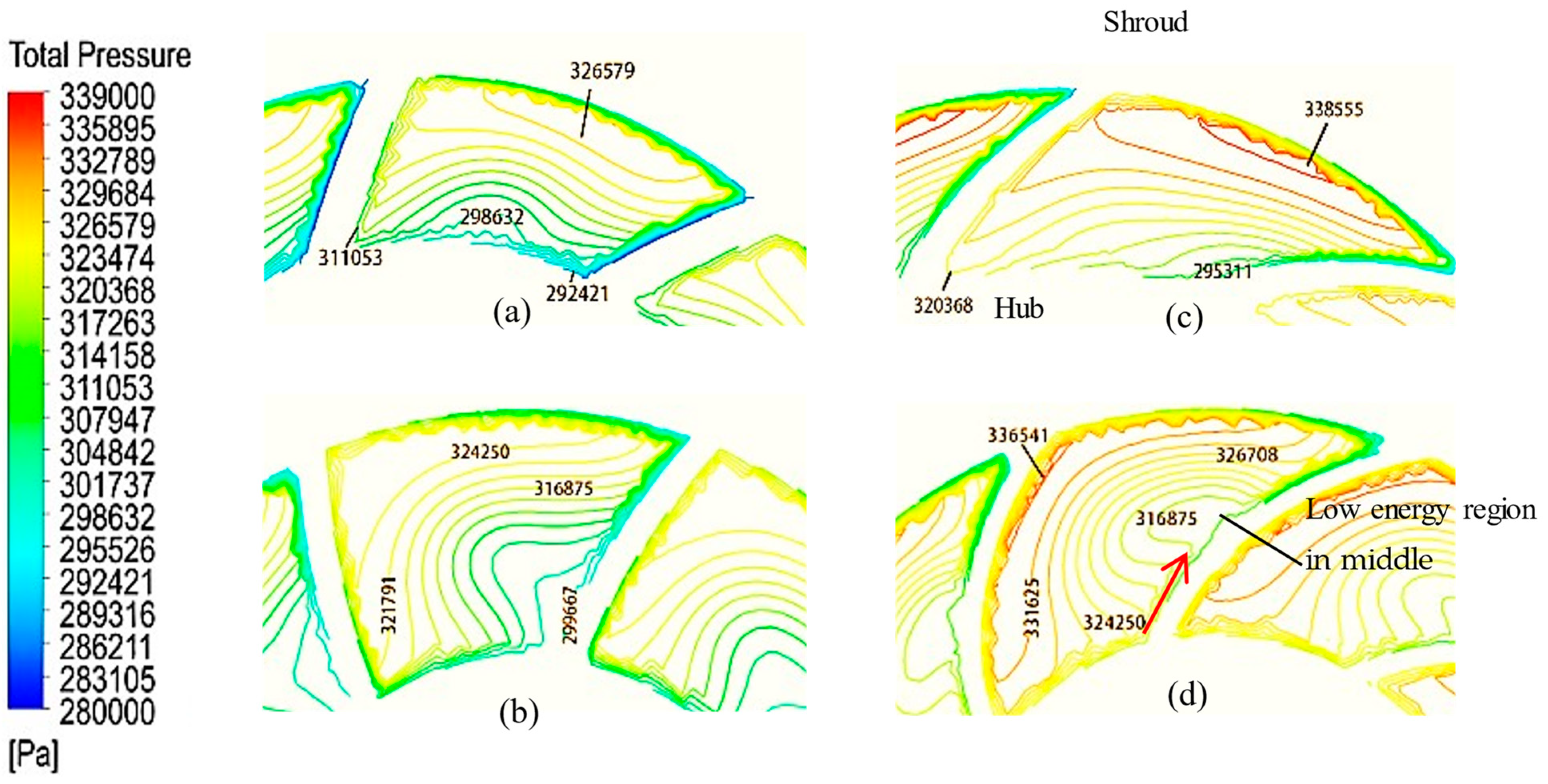


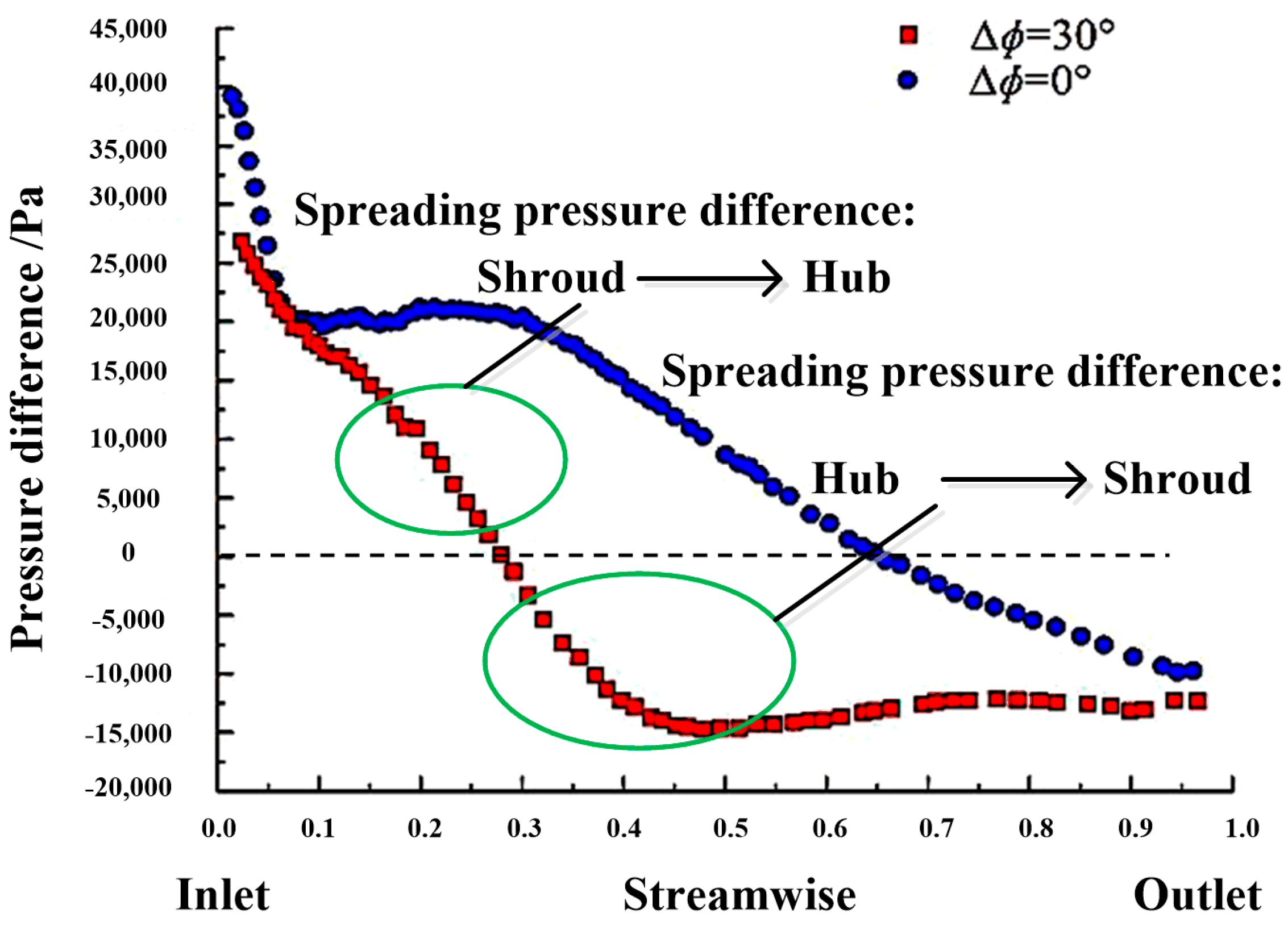

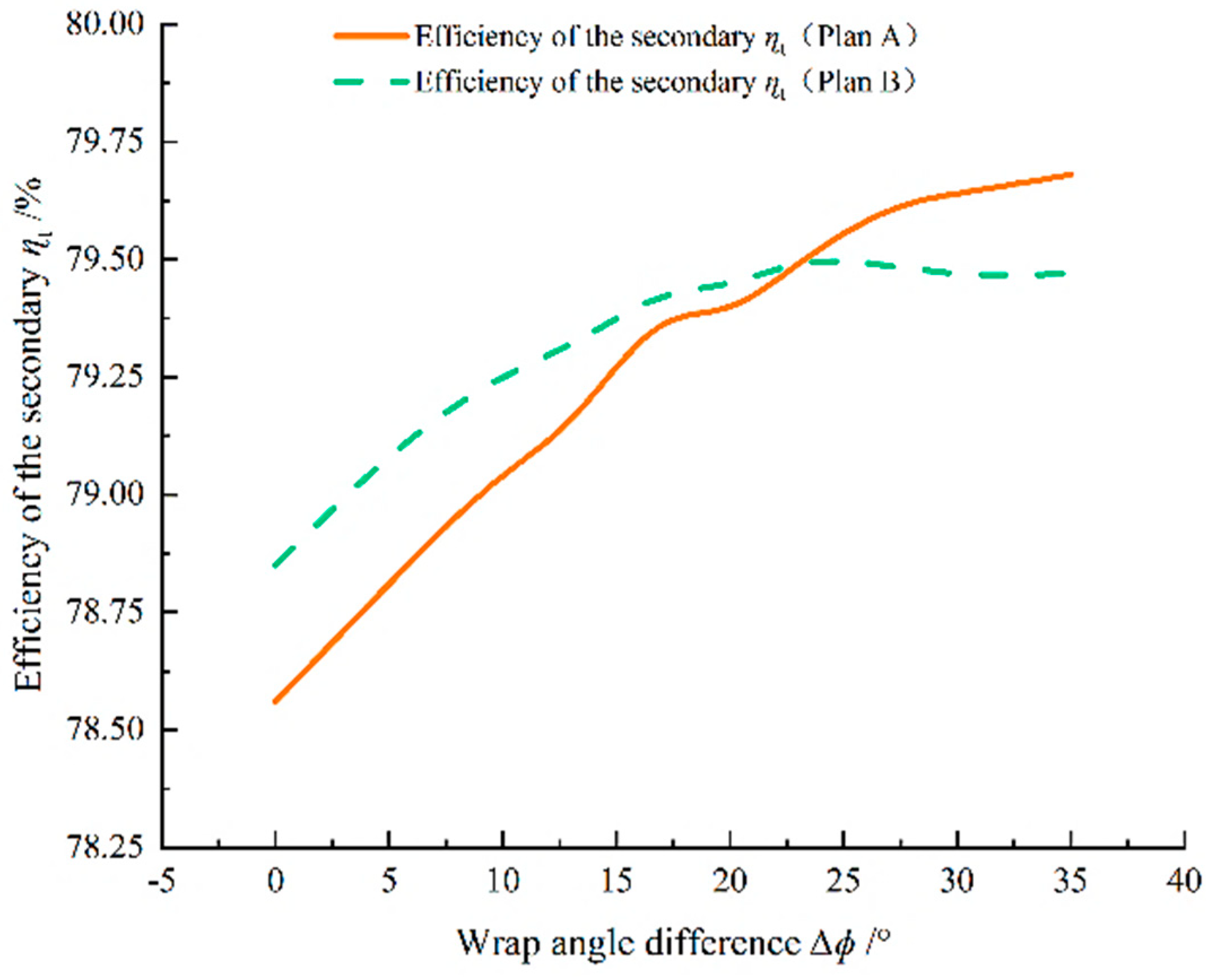


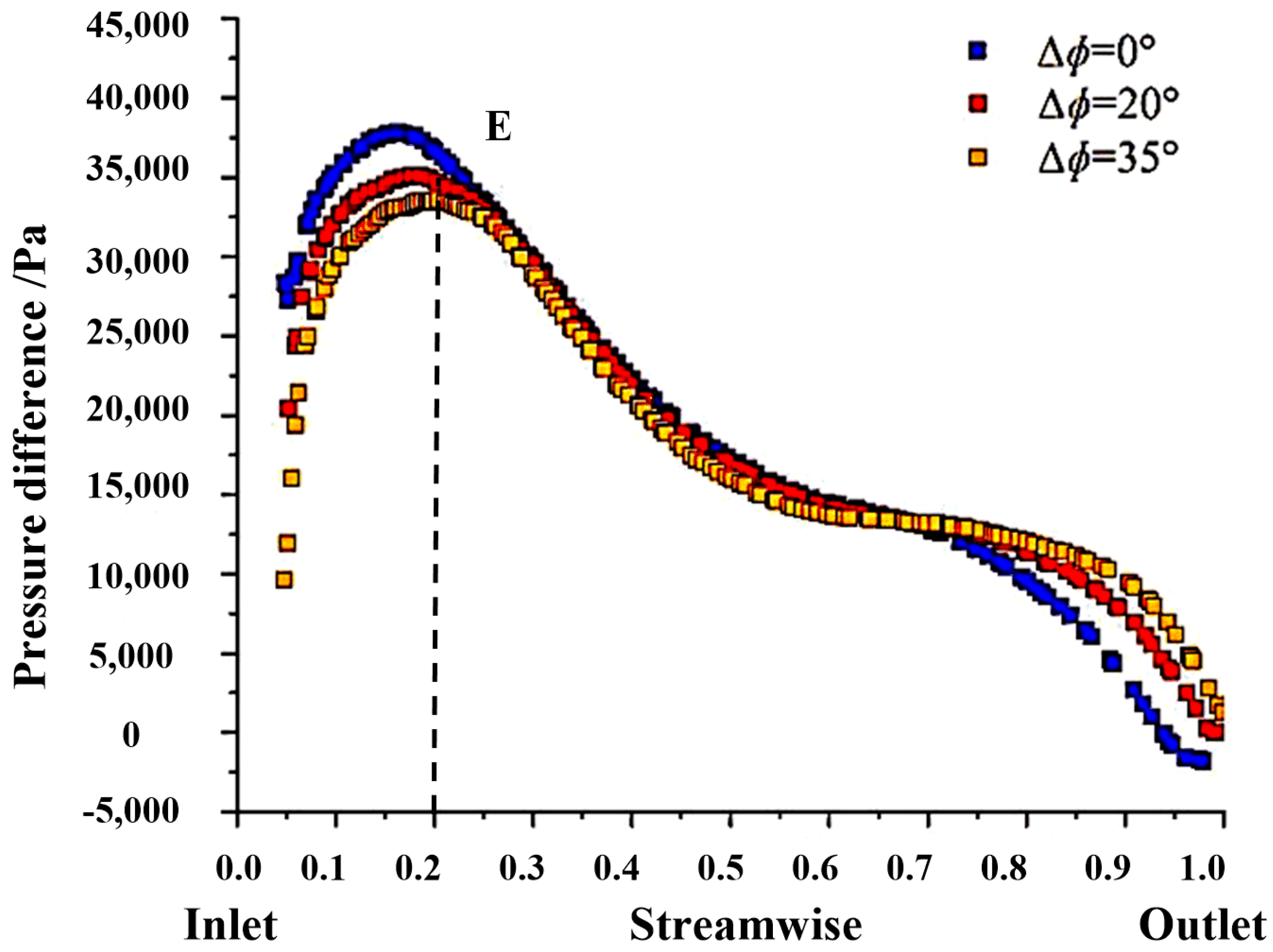
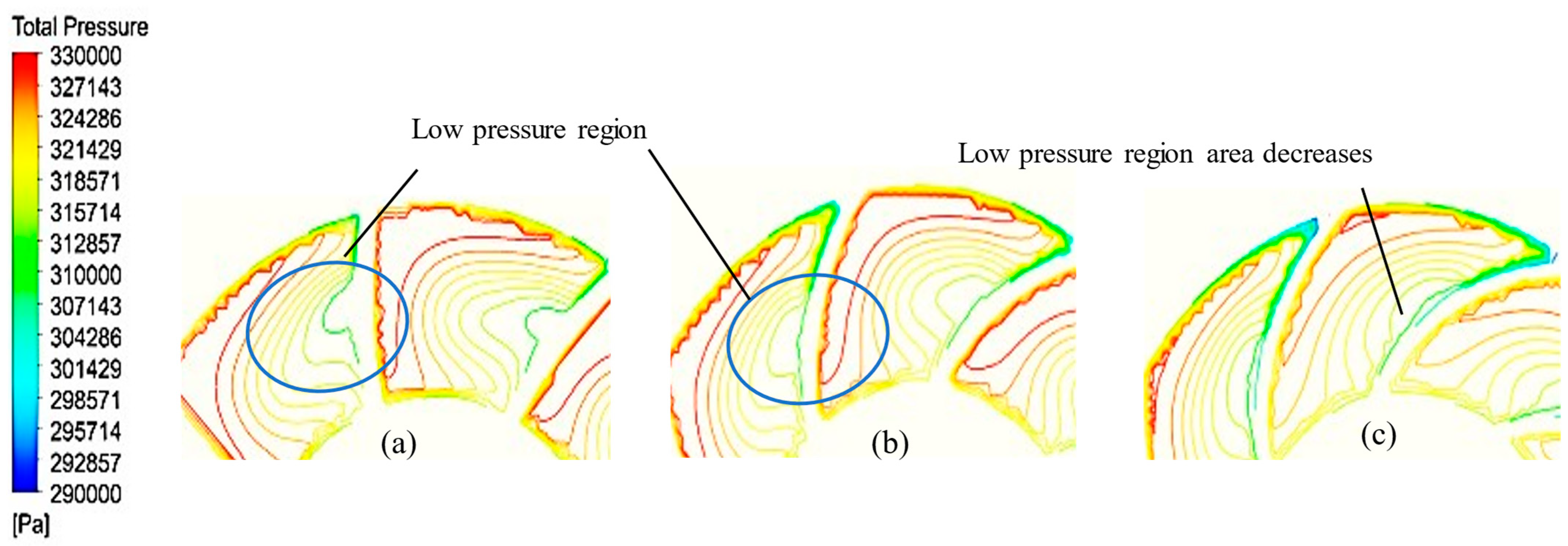
| The Impeller Parameters | |||
| Parameters | Values | Parameters | Values |
| Outlet Diameter | 138.5 mm | Outlet Width | 20 mm |
| Blade Number | 7 | ||
| The Space Diffuser Parameters | |||
| Parameters | Values | Parameters | Values |
| Inlet Diameter | 166 mm | Outlet Diameter | 92 mm |
| The Hub Wrap Angle | 83° | The Shroud Wrap Angle | 60° |
| Blade Number | 8 | ||
| Parameter | Number of Grid N (×104) | Head H/m | Diffuser Efficiency η/% |
|---|---|---|---|
| Value | 302 | 33.20 | 95.04 |
| 410 | 33.04 | 95.00 | |
| 553 | 32.86 | 94.91 | |
| 680 | 32.74 | 94.88 | |
| 837 | 32.69 | 94.88 | |
| 988 | 32.70 | 94.88 |
Disclaimer/Publisher’s Note: The statements, opinions and data contained in all publications are solely those of the individual author(s) and contributor(s) and not of MDPI and/or the editor(s). MDPI and/or the editor(s) disclaim responsibility for any injury to people or property resulting from any ideas, methods, instructions or products referred to in the content. |
© 2023 by the authors. Licensee MDPI, Basel, Switzerland. This article is an open access article distributed under the terms and conditions of the Creative Commons Attribution (CC BY) license (https://creativecommons.org/licenses/by/4.0/).
Share and Cite
Zhang, H.; Cao, P.; Ni, D.; Gong, X.; He, B.; Zhu, R. Investigation on the Impact of Trailing Edge Stacking Styles on Hydraulic Performance in the Multistage Submersible Pump Space Diffuser. Processes 2023, 11, 3358. https://doi.org/10.3390/pr11123358
Zhang H, Cao P, Ni D, Gong X, He B, Zhu R. Investigation on the Impact of Trailing Edge Stacking Styles on Hydraulic Performance in the Multistage Submersible Pump Space Diffuser. Processes. 2023; 11(12):3358. https://doi.org/10.3390/pr11123358
Chicago/Turabian StyleZhang, Hui, Puyu Cao, Dan Ni, Xuran Gong, Bo He, and Rui Zhu. 2023. "Investigation on the Impact of Trailing Edge Stacking Styles on Hydraulic Performance in the Multistage Submersible Pump Space Diffuser" Processes 11, no. 12: 3358. https://doi.org/10.3390/pr11123358
APA StyleZhang, H., Cao, P., Ni, D., Gong, X., He, B., & Zhu, R. (2023). Investigation on the Impact of Trailing Edge Stacking Styles on Hydraulic Performance in the Multistage Submersible Pump Space Diffuser. Processes, 11(12), 3358. https://doi.org/10.3390/pr11123358






